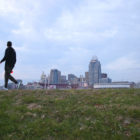The city of Newport, Kentucky, is shaped on its north and west borders by the Ohio and Licking rivers. And while Newport hosts entertainment venues and a bourbon distillery bolstered by views of Cincinnati’s skyline, its geography and history also create challenges.
As a Rust Belt town with a steel mill and a lead smelting plant no longer in use, Newport’s population of 15,000 people is half of what it was in 1960.
The community is left with many vacant lots, more concrete than greenspace, and sewers that overflow into streets and basements after a hard rain.
To slow the flow, residents have adopted the idea of strategic depaving. Depaving, or removing unnecessary pavement, creates the opportunity for more greenspace and makes it more likely that rainwater would be absorbed rather than entering the outdated infrastructure.
With the community looking to be part of the solution, the goal became to “design those amenities to provide the ecosystem services that we want from green infrastructure,” said Kirsten Schwarz, who led the effort in her capacity as director of the Northern Kentucky University Ecological Stewardship Institute.
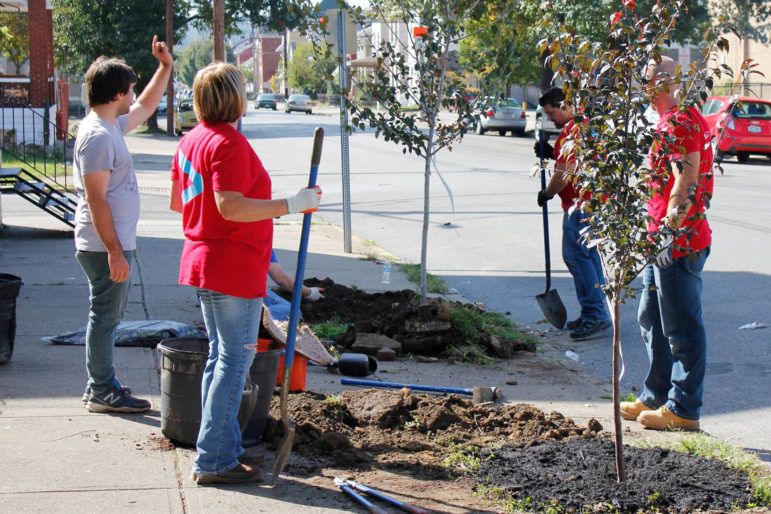
The problem: Sewer overages
With an outdated stormwater system, Northern Kentucky’s Sanitation District [SD1] sees more than 1 billion gallons annually of combined sewer overflows (storm and sanitary).
When more than a quarter inch of rain is predicted, SD1 notifies residents in its service area via their Wet Weather Notification Program to avoid direct contact with local waterways and the pathogens flowing through them.
In 2005, SD1 entered into a consent decree with the U.S. Environmental Protection Agency and the Kentucky Energy and Environment Cabinet with the intention of mitigating overflows by 2025. In February 2019, SD1 requested an extension to the year 2040.
The infrastructure upgrades needed to meet their goals is estimated to cost $1.3 billion.
“The extension will allow us to spread infrastructure capital costs over a longer period, reducing the financial impact to our customers while ensuring progress on overflow mitigation,” said SD1 Executive Director Adam Chaney.
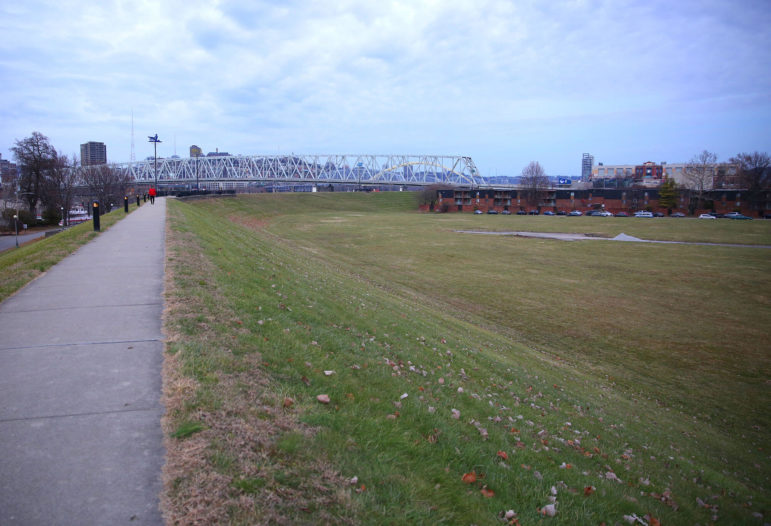
Residents look to make a difference
While SD1 is hoping for a new 2040 deadline to make its upgrades, Newport community members are seeking solutions now.
The university Ecological Stewardship Institute “wanted to work in the neighborhood on a project developed around community needs,” said Schwarz, the institute’s director.
Together with community partners ReNewport and Westside Citizens’ Coalition, they conducted a survey and found the two main things Newport community members asked for was access to greenspace and better water quality.
With that input, the coalition pitched to Newport the concept of strategic depaving.
Then, they asked at community meetings: “Where would you like to see greenspace and how would you use it?”
About six months into the community engagement that began in July 2018, the City of Newport learned of the efforts and reached out to Schwarz with an idea.
In 2015, the city built The Scholar House — a building for housing and education — on the site of the original Bernadette Watkins Park.
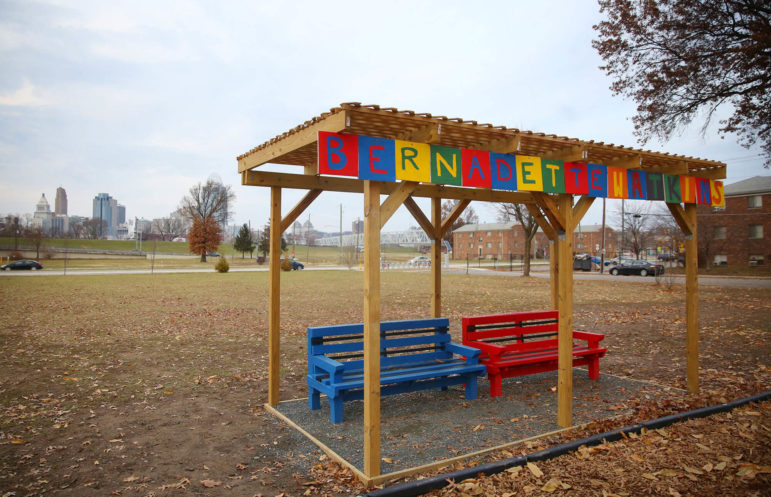
“They owed the neighborhood a park,” Schwarz said. The city had an open field directly across the street from the original park location because it demolished a housing complex there to accommodate road expansion. The city hoped it could develop a new Bernadette Watkins Park in that space and align it with the efforts of the coalition.
Thanks to a grant from Perfetti van Melle, an Italian manufacturer of confectionery and gum, the city installed playground equipment on Sept. 27. The next phase of the new Bernadette Watkins Park includes plans for rain and pollinator gardens.
“We were excited to see the results of their community input process, as it validated the city’s efforts in the park as well,” said Larisa Sims, assistant city manager of Newport and the city’s project manager for the park.
Containing stormwater
The ultimate goal of green infrastructure is to keep rainwater as close to where it falls as possible. When an urban area lacks greenspace, water can’t get absorbed and it overwhelms the wastewater collection system. Many older river cities have outdated infrastructure.
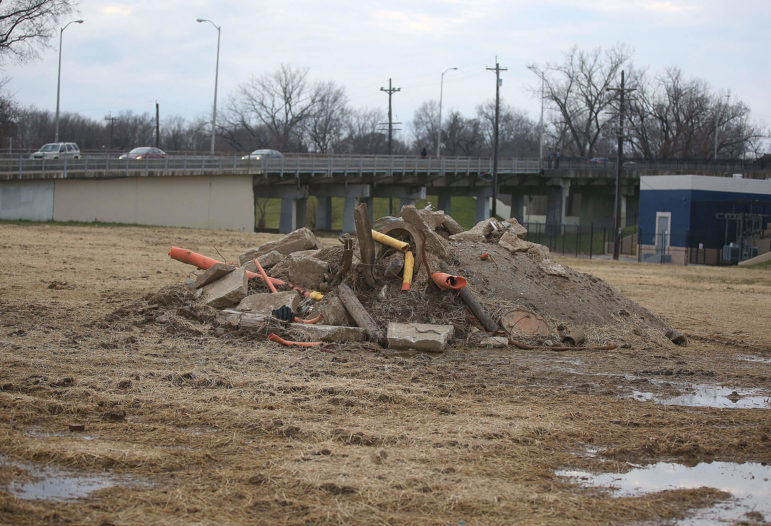
ReNewport approaches stormwater challenges in its community by assessing vacant lots for greenspace opportunities.
“We’re really trying to make as many tiny sponges around the neighborhood as possible,” said Steve Mathison, vice president for ReNewport.
They’re doing this in three ways: depaving, installing rain barrels and rain gardens, and planting trees.
Depaving isn’t as simple as getting rid of pavement and replacing it with greenery. Schwarz, who also studies contaminated soil, cautioned that while the vacant lands left behind by shrinking cities can support sustainability initiatives, “many are the same aging cities that have experienced the highest soil lead burdens from their industrial past as well as the historic use of lead-based paint and leaded gasoline.”
It’s important when taking on a depaving project that part of the strategy is understanding the history of the property and testing for contaminants, she said. It doesn’t have to stop the project, but “it can inform how you’re going to use the space,” she said.
A 2010 study conducted in the European Union took a comprehensive look at the most commonly used pavements and showed that where a sealed asphalt surface provides zero stormwater absorption, an unpaved surface provides 90% absorption.
Depaving doesn’t have to mean pulling up concrete in an abandoned lot. Switching from conventional asphalt to porous asphalt on a driveway can reduce imperviousness by as much as 50%.
Rain barrels collect water from rooftops and store it for later use in gardens, lawns or even indoor plants. A drip line on a rain barrel also helps slowly release the collected water for better absorption. This not only reduces stormwater overload but also reduces water costs during dry spells.
Rain gardens can be helpful if the property has a low spot that tends to pool or sludge during rain events. A rain garden is designed to intercept rainwater and slow it down.
Campbell County, Kentucky, (where Newport is located) offers residents financial assistance when implementing conservation practices in their own backyards.
Planting trees is vital to the urban landscape. Water is intercepted on tree leaves and bark surfaces, and trees suck it up from the soil. Trees also improve infiltration of water into the soil and clean the air.

Adam Berland is an assistant professor of geography for Ball State University and researches urban forestry.
“A newly planted tree, one you can carry around, won’t do much in the beginning but, by the time it’s 20 years old, it will be doing a good amount of stormwater management,” he said, adding that existing trees should be taken care of before planting new ones.
Most cities have an arborist or a county extension office with a list of recommended trees for the area, as well as ones to avoid.
Online tools such as Mytree.itreetools.org can provide data, such as how much water has been intercepted and how much runoff has been avoided. For example, an oak tree about 17 inches in diameter can intercept 1,800 gallons of water per year.
Newport’s green future
While the Bernadette Watkins Park was being reestablished on the west side of Newport, ReNewport had another depaving project planned for the east side. They acquired a lot that was once a gas station. They pulled concrete, tested and leveled the soil, and planted trees along its perimeter. More community engagement forums will help decide the future of the space.
ReNewport has decided to take what Northern Kentucky University began and formally adopt a strategic depaving project for Newport. The organization has identified more than 100 lots within the city with future greenspace potential.
“ReNewport has been involved since the very beginning,” Schwarz said, “and we’re so excited they want to take it over.”
Strategic depaving wasn’t something that was necessarily in ReNewport’s plan aside from beautifying lots, Mathison said.
But “it captures the spirit of multiple small organizations coming together to create a bigger project and have a positive impact on stormwater issues. We’re looking forward to seeing positive results in the neighborhood within the next year.”
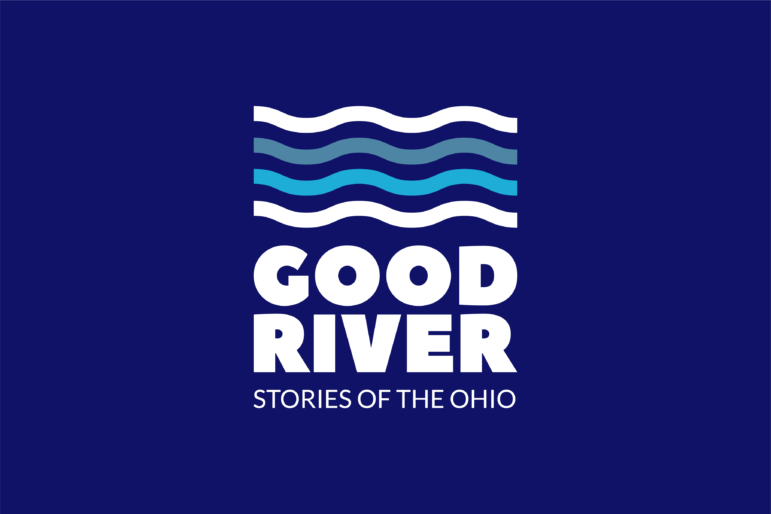
Bonnie Jean Feldkamp is a Cincinnati-based freelance writer. Find her on social media @WriterBonnie or at WriterBonnie.com.
Good River: Stories of the Ohio is a series about the environment, economy, and culture of the Ohio River watershed, produced by seven nonprofit newsrooms. To see more, please visit ohiowatershed.org.

